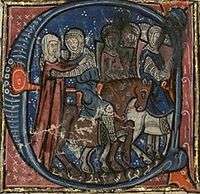Ida of Lorraine
| Ida of Lorraine | |
|---|---|
 | |
| Spouse(s) | Eustace II of Boulogne |
| Children |
Eustace III Godfrey of Bouillon Baldwin I |
| Parent(s) |
Godfrey III, Duke of Lower Lorraine Doda |
Ida of Lorraine (also referred to as Blessed Ida of Boulogne)[1] (c. 1040 – 13 April 1113)[2] was a saint and noblewoman.
She was the daughter of Godfrey III, Duke of Lower Lorraine and his wife Doda.[3] Ida's grandfather was Gothelo I, Duke of Lorraine and Ida's brother was Godfrey IV, Duke of Lower Lorraine.
Family
In 1049, she married Eustace II, Count of Boulogne.[2] They had three sons:
- Eustace III, the next Count of Boulogne
- Godfrey of Bouillon, first ruler of Kingdom of Jerusalem
- Baldwin, second ruler of Kingdom of Jerusalem
A daughter, Ida of Boulogne, has also been postulated. She was married first to Herman von Malsen and second to Conon, Count of Montaigu.
Ida shunned the use of a wet-nurse in raising her children. Instead, she breast-fed them to ensure that they were not contaminated by the wet-nurse's morals, i.e. her mode of living.[4] When her sons went on the First Crusade, Ida contributed heavily to their expenses.[5]
Life
Ida was always religiously and charitably active, but the death of her husband provided her wealth and the freedom to use it for her projects. She founded several monasteries:
- Saint-Wulmer in Boulogne-sur-Mer[1][6]
- Our Lady of the Chapel, Calais[1]
- Saint-Bertin[1]
- Abbey of Cappelle[7]
- Abbey of Le Wast[7]
She maintained a correspondence with Anselm of Canterbury. Some of Anselm’s letters to Ida have survived.[8][9]
She became increasingly involved in church life. However, current scholarship feels that she did not actually become a Benedictine Nun, but that she was a “Secular Oblate of the Benedictine Order”.[1][6]
Death and burial
Ida died on 13 April 1113, which is the date she is honoured. Traditionally, her burial place has been ascribed to the Monastery of Saint Vaast.[6] Her remains were moved in 1669 to Paris and again in 1808 to Bayeux.[1]
Her life story was written by contemporary monk of Saint Vaast Abbey.[6]
She is venerated in Bayeux.[1]
References
- 1 2 3 4 5 6 7 Butler, Alban; Burns, Paul (2000). Butler's Lives of the Saints. Continuum International Publishing Group. p. 94. ISBN 0-86012-253-0.
- 1 2 Holböck, Ferdinand (2002). Married Saints and Blesseds. Ignatius Press. p. 147. ISBN 0-89870-843-5.
- ↑ Butler, Alban; Burns, Paul (2000). Butler's Lives of the Saints. Continuum International Publishing Group. p. 93. ISBN 0-86012-253-0.
- ↑ Tanner, Heather (2004). Families, Friends, and Allies: Boulogne and Politics in Northern France and England c. 879-1160. Boulogne-sur-Mer (France): BRILL. p. 262. ISBN 90-04-13243-0.
- ↑ Tanner, Heather (2004). Families, Friends, and Allies: Boulogne and Politics in Northern France and England c. 879-1160. Boulogne-sur-Mer (France): BRILL. p. 135. ISBN 90-04-13243-0.
- 1 2 3 4 Holböck, Ferdinand (2002). Married Saints and Blesseds. Ignatius Press. p. 148. ISBN 0-89870-843-5.
- 1 2 Tanner, Heather (2004). Families, Friends, and Allies: Boulogne and Politics in Northern France and England c. 879-1160. Boulogne-sur-Mer (France): BRILL. p. 140. ISBN 90-04-13243-0.
- ↑ Tanner, Heather (2004). Families, Friends, and Allies: Boulogne and Politics in Northern France and England c. 879-1160. Boulogne-sur-Mer (France): BRILL. pp. 123, footnote. ISBN 90-04-13243-0.
- ↑ Vaughn, Sally N. (1990). "St. Anselm and Women". Haskins Society Journal. University of South Carolina. 2: 86. ISBN 1-85285-059-0.
Sources
- Butler, Alban; Burns, Paul (2000). Butler's Lives of the Saints. Continuum International Publishing Group. ISBN 0-86012-253-0.
- Holböck, Ferdinand (2002). Married Saints and Blesseds: Through the Centuries. Ignatius Press. ISBN 9780898708431.
- Tanner, Heather (2004). Families, Friends, and Allies: Boulogne and Politics in Northern France and England c. 879-1160. Boulogne-sur-Mer (France): BRILL. ISBN 90-04-13243-0.
- Vaughn, Sally N. (1990). "St. Anselm and Women". Haskins Society Journal. University of South Carolina. 2: 83–94. ISBN 1-85285-059-0.